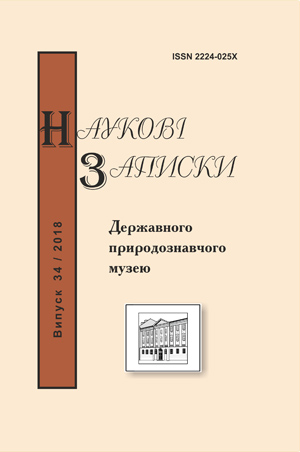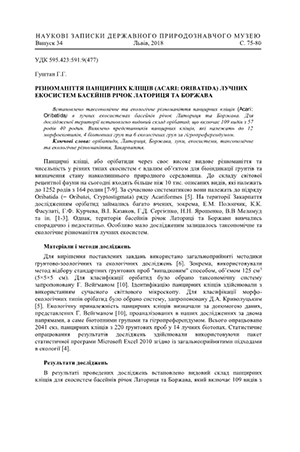Hushtan H. H.
The diversity of oribatid mites (Acari: Oribatida) of grassland ecosystems of Latorica and Borzhava river basins // Proc. of the State Nat. Hist. Mus. - Lviv, 2018. - P.75-80. DOI: https://doi.org/10.36885/nzdpm.2018.34.75-80 Key words: Oribatid mites, Latoritsa, Borzhava, grasslands, ecosystems, taxonomic and ecological diversity, Transcarpathia The diversity of oribatid mites (Acari: Oribatida) of grassland ecosystems of Latorica and Borzhava river basins As a result of our research, taxonomic and ecological diversity of oribatid mites in the ecosystems of the basins of the Latoritsa and Borzhava rivers has been established. For the studied territory, the species composition of the oribatid mites is established, which includes 109 species (57 genus, 40 families). The dominant qualitatively are the following families of oribatid mites: Oppiidae, Suctobelbidae, Brachychthoniidae, Scheloribatidae, Oribatulidae. The richest qualitative composition is represented by the Oribatida of the following genera: Suctobelbella, Scheloribates, Oppiella, Achipteria, Ramusella, Steganacarus, Notrus, Scutovertex, Ceratozetes, Punctoribates. The ecological diversity of oribatid mites is investigated. There are 12 morphoekotypes (METs) of Oribatida for the Latoritsa and Borzhavy river basins. The most represented are 4 METs (10-26 species per morphoecotype). For the investigated ecosystems, representatives of 4 biotope groups of oribatid mites: forest, forest-meadow, meadow and eurytopic species. The studied groups of Oribatids are 6 ecological groups by hygropreferendum. These include hygrophilous, hygro-mesophilous, mesophilous, meso-xerophilous, xerophilous and eurybiontic. The most diverse in terms of quality are the forest biotopic group and species-hygrophilous (31 and 30 species, respectively).
The diversity of oribatid mites (Acari: Oribatida) of grassland ecosystems of Latorica and Borzhava river basins // Proc. of the State Nat. Hist. Mus. - Lviv, 2018. - P.75-80. DOI: https://doi.org/10.36885/nzdpm.2018.34.75-80 Key words: Oribatid mites, Latoritsa, Borzhava, grasslands, ecosystems, taxonomic and ecological diversity, Transcarpathia The diversity of oribatid mites (Acari: Oribatida) of grassland ecosystems of Latorica and Borzhava river basins As a result of our research, taxonomic and ecological diversity of oribatid mites in the ecosystems of the basins of the Latoritsa and Borzhava rivers has been established. For the studied territory, the species composition of the oribatid mites is established, which includes 109 species (57 genus, 40 families). The dominant qualitatively are the following families of oribatid mites: Oppiidae, Suctobelbidae, Brachychthoniidae, Scheloribatidae, Oribatulidae. The richest qualitative composition is represented by the Oribatida of the following genera: Suctobelbella, Scheloribates, Oppiella, Achipteria, Ramusella, Steganacarus, Notrus, Scutovertex, Ceratozetes, Punctoribates. The ecological diversity of oribatid mites is investigated. There are 12 morphoekotypes (METs) of Oribatida for the Latoritsa and Borzhavy river basins. The most represented are 4 METs (10-26 species per morphoecotype). For the investigated ecosystems, representatives of 4 biotope groups of oribatid mites: forest, forest-meadow, meadow and eurytopic species. The studied groups of Oribatids are 6 ecological groups by hygropreferendum. These include hygrophilous, hygro-mesophilous, mesophilous, meso-xerophilous, xerophilous and eurybiontic. The most diverse in terms of quality are the forest biotopic group and species-hygrophilous (31 and 30 species, respectively).
References
- Hushtan H.H. Istoriia doslidzhen pantsyrnykh klishchiv (Acari: Oribatida) luchnykh ekosystem Palearktyky // Vnesok naturalistiv-amatoriv u vyvchennia biolohichnoho riznomanittia: Mat- ly mizhnar. nauk. konf. prysviachenoi 200-richchiu vid dnia narodzhennia Liudviha Vahnera. – 2015. – S. 218-223. [In Ukrainian]
- Melamud V.V. Kataloh pantsyrnykh klishchiv (Acari: Oribatida) Zakarpatskoi oblasti I // Nauk. visn. Uzhhorod. un-tu. Seriia Biolohiia. – 2008. – Vyp. 23. – S. 198-208. [In Ukrainian]
- Melamud V.V. Kataloh pantsyrnykh klishchiv (Acari: Oribatida) Zakarpatskoi oblasti II // Nauk. visn. Uzhhorod. un-tu. Seriia Biolohiia. – 2009. – Vyp. 26. – S. 85-98. [In Ukrainian]
- Megarran E. Ekologicheskoe raznoobrazie i ego izmerenie. – M.: Mir, 1992. – 181 s. [In Russian]
- Pantcirnye kleshchi: morfologiia, filogeniia, ekologiia, metody issledovaniia, kharakteristika modelnogo vida Nothrus polustris C. L. Koch, 1839 / [D.A. Krivolutckii, F. Labren, M. Kunst ta іn.]. – M.: Nauka, 1995. – 224 s. [In Russian]
- Potapov M.B., Kuznetcova N.A. Metody issledovaniia soobshchestv mikroartropod: posobie dlia studentov i aspirantov // M.: T-vo nauchnykh izdanii KMK, 2011. – 84 s. [In Russian]
- Schatz H. Die Oribatidenliteratur und die beschriebenen Oribatidenarten (1758-2001): Eine Analyse // Abh. Ber. Naturk. Görlitz. – 2002. – 74. – P. 37-45.
- Schatz H. Diversity and global distribution of oribatid mites - evaluation of the present state of knowledge // In Weigmann et al. – 2005. – P. 485-500.
- Subias L.S. Listado sistemático, sinonímico y biogeográfico de los ácaros oribátidos (Acariformes: Oribatida) del mundo (excepto fósiles). – 2017. – 598 p.
- Weigmann G. Acari, Actinochaetida Hornmilben (Oribatida). – Keltern: Goeck e & Evers, 2006. – 520 p.


